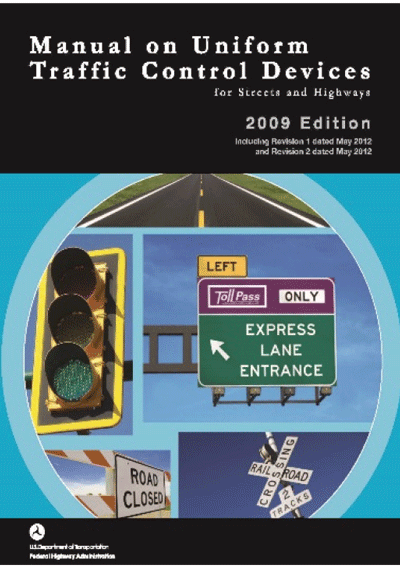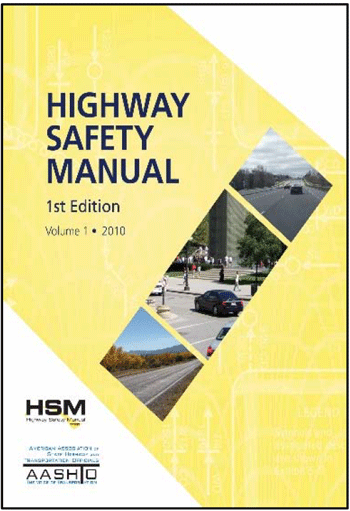CHAPTER 1. INTRODUCTION
SAFETY PROBLEMS AT HORIZONTAL CURVES
In 2013, there were 5.7 million crashes reported in the United States, including 32,719 fatalities and more than 2.3 million injuries (NHTSA, 2014). More than half of the 2013 fatalities occurred as a result of roadway departure crashes. Vehicles are more likely to leave the travel lane of a roadway where the roadway alignment changes direction. These locations are known as horizontal curves.
A comprehensive, four-state study by Glennon et al. (1985) found that the average crash rate for horizontal curves on two-lane rural highways is three times higher than on tangent road segments. The authors also found that the average single-vehicle run-off-road crash rate was four times higher on horizontal curves than on tangent segments. The severity of roadway departure crashes on horizontal curves was also higher than roadway departure crashes on tangent segments. A more recent study by Hummer et al. (2010) found similar results. An analysis of North Carolina crash data found that curve collisions have more than three times the fatality rate of collisions on all roads statewide. One study on different combinations of horizontal and vertical curve alignments found that crash frequency increases with decreasing horizontal curve radius, decreasing horizontal curve length, increasing grade difference, and increasing percent grade (Bauer and Harwood, 2014).
A Guide for Reducing Collisions on Horizontal Curves (NCHRP Report 500, Volume 7) further illustrates the problem. The NCHRP Report 500, Volume 7, reports that nearly 25 percent of people who die each year on the Nation's roadways are killed in vehicle crashes at curves. About 75 percent of all fatal crashes occur in rural areas, and more than 70 percent are on two-lane secondary highways, many of which are local roads. Approximately 76 percent of the curve-related fatal crashes involve single vehicles leaving the roadway and striking trees, utility poles, rocks, or other fixed objects or overturning. Another 11 percent are head-on crashes, the result of one vehicle drifting into the opposing lane when a driver tries to cut the curve or redirect the vehicle after having run onto the shoulder.
In 2012, a team comprised of the Federal Highway Administration (FHWA) Office of Safety, Office of Safety Research and Development, and Resource Center Safety and Design Technical Services developed Safe Roads for a Safer Future – A Joint Safety Strategic Plan (SSP). The vision presented in the SSP works "toward zero deaths and serious injuries on the Nation's roadways." This publication provides agencies with information to help them deploy the appropriate countermeasures on horizontal curves in support of this vision.
PUBLICATION PURPOSE AND SCOPE
The NCHRP Report 500, Volume 7, identified several strategies to address the specific safety problem at horizontal curves. These strategies meet one of the following two objectives:
- Reduce the likelihood of a vehicle leaving its lane and either crossing the roadway centerline or leaving the roadway at a horizontal curve.
- Minimize the damaging consequences of a vehicle leaving the roadway at a horizontal curve.
Although the NCHRP Report 500, Volume 7, provides information about each strategy, transportation professionals indicated that a document providing practical information on where, when, and how to apply a safety countermeasure or design feature—including examples and costs—would be valuable to local road agencies. To respond to this need, the FHWA created the Low-Cost Treatments for Horizontal Curve Safety (McGee and Hanscom, 2006). There have been many advances in highway safety since that initial 2006 guide. The purpose of this publication is to serve as an update to the 2006 Low-Cost Treatments for Horizontal Curve Safety. The primary audience for this publication is local transportation agencies.
An agency can apply a number of strategies or countermeasures to a single horizontal curve or a winding road section to address a safety problem. This publication primarily includes those engineering countermeasures that are relatively low-cost, such as signage and pavement markings. More moderate or higher cost treatments including varying degrees of infrastructure changes are also provided as appropriate, including superelevation, cross section, and shoulder adjustments.
This publication presents summary information and is not meant to cover all aspects of an individual countermeasure in detail. Rather, this publication provides information specifically relating to lower volume two-lane roads and the agencies that manage them. It will help transportation agencies and their crews understand the available countermeasures and how to select and apply them. Where appropriate, and when information was available, this publication provides the following for each countermeasure:
- Description: General description of the countermeasure.
- Design: Identification of which design elements or materials to use.
- Applications: How to apply the countermeasure(s).
- Effectiveness: A countermeasure's effectiveness in improving safety.
- Relative Cost: Identification of the relative cost, such as low-cost (e.g. signs, pavement markings), moderate cost, or high cost (e.g., changes to infrastructure).
ABOUT THE Manual on Uniform Traffic Control Devices (MUTCD)
References to the FHWA's Manual on Uniform Traffic Control Devices (MUTCD) (FHWA, 2009) occur throughout this document (Figure 1). The MUTCD defines the standards for all traffic control devices that road managers install and maintain to help regulate, warn, and guide drivers safely on the Nation's roadways and streets, such as signs, signals, and pavement markings. All States are required to adopt either the Federal MUTCD (FHWA) or a State MUTCD that is in substantial conformance to the Federal MUTCD. Some States adopt the Federal MUTCD with a State Supplement. An agency should consult State laws regarding traffic control devices.

Figure 1. Photo. The MUTCD provides standards and guidance for installation, placement, and use of traffic control devices.
The MUTCD also defines conditions about what, where, and how to place or install a traffic control device. In different chapters of this publication you may see a countermeasure and the designation that the MUTCD states "shall be used." Shall means something is a standard-a practice or device that is specifically required or mandated-or, in the case of "shall not be used," explicitly prohibited. The MUTCD may designate other countermeasures as guidance, which indicates that a practice or device is recommended and should be used in typical situations, with modifications allowed for a specific location if an engineering study or engineering judgment indicates the deviation to be appropriate. Finally, the MUTCD provides for options, which are presented as "may" statements.
To learn more about the MUTCD, visit the Manual on Uniform Traffic Control Devices.
In addition to the traffic control devices required by the MUTCD (per "shall" statements), road agencies should consider installing other devices at horizontal curves, especially at curves that data or experience identify as having a safety problem.
Agencies generally apply traffic control devices uniformly based on the sharpness of the curve. This uniformity provides drivers with a consistent message on which to base their driving expectations. The MUTCD provides specific recommendations and requirements for uniform application of these devices. Agencies may apply treatments to a single, problematic curve that has a history of crashes, or they may also choose to install countermeasures at curves with similar characteristics across the roadway network. These system-wide, preventative measures are known as systemic improvements, and are discussed further in Chapter 2. Any additional use should be based on the information and recommendations contained in an engineering study or an engineer's judgment. Factors to consider include:
- The difference between the posted speed limit and advisory speed.
- Geometric features of the curve including its length, radius, shoulders, and roadside features.
- Available sight distance approaching and within the curve limits.
- Unexpected geometric features within the curve, such as an intersection, change in grade, change in curve radius, or visual cues that violate driver expectations.
- A sudden change in alignment after many miles of consistently straight roadway.
- Traffic volume.
- Risk characteristics including crash frequency and crash severity.
ABOUT THE HIGHWAY SAFETY MANUAL AND CMF CLEARINGHOUSE
Throughout this publication readers will also see reference to the American Association of State Highway and Transportation Officials' (AASHTO) Highway Safety Manual (HSM) (AASHTO, 2010) and the FHWA Crash Modification Factor (CMF) Clearinghouse. The HSM includes technical content related to road safety fundamentals, the road safety management process, and crash prediction methods for several roadway types. It also includes CMFs for many roadway geometric design elements and traffic control devices. When applicable, thispublication uses safety effect estimates from the HSM when describing the benefits of a horizontal curve safety countermeasure.

Figure 2. Photo. The Highway Safety Manual provides road safety fundamentals and management as well as crash prediction methods. Source: AASHTO.
The CMF Clearinghouse is the largest collection of CMFs for geometric design elements and traffic control devices available in the United States. The CMF Clearinghouse employs a "star rating" system to indicate the quality of the CMF based on factors such as the evaluation method, sample size, and standard error. The star rating system ranges from "1" (least reliable) to "5" (most reliable rating). This publication provides the star rating for each CMF discussed. Readers of this publication are encouraged to refer to the CMF Clearinghouse for specific horizontal curve safety issues not covered in this publication.
INFORMATION IN THIS PUBLICATION
The following considerations should be taken into account when reading and using the information contained in this publication:
- The publication includes estimates of the effectiveness of the countermeasure in reducing crashes where such evaluation information is available. However, agencies should not expect to obtain exactly these crash reduction values at a specific location, as the actual observed effectiveness of a countermeasure will vary from site to site.
- Some countermeasures included in this publication use supports or posts, such as signs, which make them an obstacle that could be hit. The MUTCD states that roadside sign supports in the clear zone shall be breakaway, yielding, or shielded with a longitudinal barrier or crash cushion. Information on breakaway sign supports and the definition of clear zone can be found at Breakaway Hardware.
PUBLICATION ORGANIZATION
The FHWA encourages readers to use the information presented in this publication to evaluate problems and identify appropriate countermeasures for problem curve sections. Applying these countermeasures will help agencies reduce roadway departure crashes and resulting injuries and fatalities.
The rest of this publication is organized into the following chapters:
Chapter 2: The Two Components of Safety Improvement: Site Analysis and the Systemic Approach
Chapter 3: Markings
Chapter 4: Signs
Chapter 5: Pavement Countermeasures
Chapter 6: Roadside Improvements
Chapter 7: Addressing Intersections in Curves
References
Glossary
Appendices – Case Studies
Appendix A: Low-Cost Safety Improvements in Pennsylvania
Appendix B: Systemic Improvements in Minnesota
Appendix C: Application of Edge Lines in Missouri
Appendix D: Upgrading Curve Signing in Ohio
Appendix E: Application of Sequential Dynamic Curve Warning Systems
Appendix F: Application of High Friction Surface Treatment in Kentucky
Appendix G: Every Day Counts – High Friction Surface Treatments
Appendix H: Utility Pole Management in New Jersey
